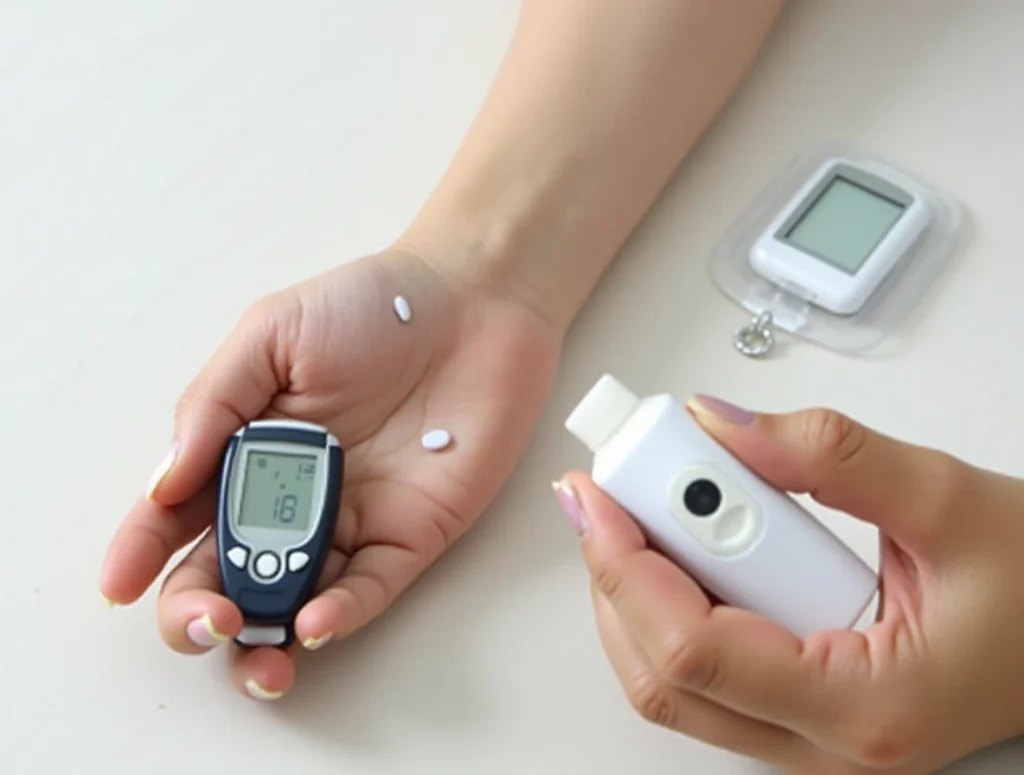Keeping your blood sugar levels accurate is key for people with diabetes. A vital tool is glucose control solution. It’s a liquid that checks if your glucose meter and test strips work right.
Testing with control solution makes sure your readings are trustworthy. This lets you make smart choices about your health and managing diabetes.
Knowing how to use control solution helps you track your blood sugar well. This guide will teach you how to use it right. You’ll learn how to keep your glucose meter accurate.

Understanding Blood Glucose Control Solution
Blood glucose control solution is key for getting accurate blood glucose readings. It’s made of water, glucose, buffers, and microbicides. These ingredients are designed to mimic human blood. This ensures your glucose meter and test strips work right, helping you manage your diabetes well.
Components and Properties
The solution has a set amount of glucose and other ingredients like buffers and microbicides. These work together to match human blood’s properties. The glucose and pH levels are set to give you a reliable test for your blood glucose.
Why Control Solution Matters
Using a glucose control solution is vital for accurate blood glucose readings. It checks if your meter and test strips are working right. This prevents wrong results that could harm your diabetes care. Regular use of the control solution means you can trust your blood glucose testing accuracy, helping you make better health choices.
How Blood Glucose Control Solution Works
The glucose meter calibration and control solution testing are key for accurate blood glucose readings. Control solution acts like real blood. It lets you check if your glucose meter and test strips work right.
When you use the control solution on a test strip, the meter should show a reading in a certain range. This range matches the glucose level in the control solution. It can be low, normal, or high. Testing with different levels helps check your whole blood glucose system.
This testing process is a solid way to make sure your glucose meter is calibrated right. It helps spot any problems with your gear or how you test. This ensures your blood glucose readings are reliable and help manage diabetes well.

When to Use Control Solution Testing
Keeping your glucose meter in good shape is key to managing your diabetes well. Regular control solution testing is a must for your diabetes care routine.
Common Testing Scenarios
You should test your glucose meter with control solution if you think it’s not working right. This might happen if you get results that don’t make sense, damage your meter, or spill something on it. Also, test it when you start a new pack of test strips or if they’ve been in extreme conditions.
Emergency Situations
In emergency cases, like when your blood sugar is way too high or low, control solution testing is very helpful. It lets you know if your meter is giving you accurate readings. This way, you can trust your results and handle your blood sugar levels safely.
Preventive Testing Guidelines
To keep your glucose meter in top shape, test it with control solution at least once a week. This keeps your meter and test strips working right, helping you manage your diabetes better. Also, do a control solution test if you get a new meter or if your test results don’t match how you feel.
Step-by-Step Testing Process
Testing your glucose meter with a control solution is very important. It helps make sure your readings are accurate. Here’s how to do it right: blood glucose control solution. blood glucose control solution.
1. First, put a new test strip into your glucose meter. This gets it ready for the test.
2. Next, shake the control solution bottle well. This mixes it up so you get a good reading.
3. Then, throw away the first drop of solution and clean the bottle tip. This keeps the test clean and free from contamination.
4. Now, put a small drop of the solution on a clean, dry area. Don’t touch the test strip to the bottle tip.
5. Place the test strip on the solution drop until the meter says it’s ready. Let it finish the test.
6. Finally, check the meter’s result against the range on the test strip or solution packaging. This range shows what reading you should see.
For specific steps for your meter, always check the manufacturer’s guide. Following the right steps is crucial for reliable blood sugar checks.
Control Solution Storage and Shelf Life
Storing your blood glucose control solution right is key for good test results. It stays good for 3 months after you open it or until the date on the bottle, whichever is sooner.
Proper Storage Conditions
Keep your control solution at room temperature, between 39–86°F (4–30°C). Don’t put it near direct sunlight, heaters, or the fridge. Keep the humidity between 10–90%. Freezing it can ruin its use.
Expiration Guidelines
Always check the expiration date on your control solution bottle. Throw it away after the date or 3 months, whichever comes first. Close the bottle tightly after each use to keep it clean and effective. If you’re not sure when it expires, write the date you opened it.
Following these storage and expiration tips helps keep your diabetes supplies and control solution tests accurate. This leads to better blood glucose management.
Interpreting Control Solution Test Results
It’s very important to check your glucose meter’s accuracy. Control solution testing is the way to do this. The result should be within the range given on the test strip vial. This range allows for small differences between tests, showing your meter and strips are working right.
If the test result is outside this range, there might be a problem. You should reach out to the meter maker for help or a new one. Remember, control solution tests don’t show your blood sugar levels. They just check if your meter and strips are accurate.
The FDA says glucose meters must be within 15% of lab values 95% of the time. Control solution tests help make sure your meter meets this rule. By testing regularly, you can be sure your glucose meter is accurate and you can trust the readings, even if they’re not in the control solution range.
Control solution tests have 2-3 different glucose levels to check your meter’s accuracy. If one strip works, the whole batch probably does too. But, if a test fails, it might mean there’s a bigger problem with your test strips. blood glucose control solution.

Common Mistakes to Avoid During Testing
Keeping your glucose meter accurate is key to managing your blood sugar. But, even careful people can make mistakes during testing. Knowing these common errors can help you get reliable readings from your meter.
Testing Errors
One big mistake is using old or wrong control solution. Solutions expire and must be stored right to work well. Using expired or wrong solution can mess up your readings.
Also, not shaking the solution bottle or using the wrong amount on the test strip can cause errors. These small mistakes can make a big difference in your results. blood glucose control solution.

Solution Handling Mistakes
Another mistake is mixing up control solution with blood. Always use the solution, not your blood, on the test strip. Make sure to cover the strip fully for accurate results. blood glucose control solution.
Not cleaning the bottle tip after each use can also lead to bad readings. This is because of contamination.
Remember, control solution is only for testing and should not be eaten. Use it only to check your meter’s accuracy.
By watching out for these mistakes and following the maker’s guide, you can keep your meter accurate. This ensures your testing is reliable for managing diabetes.
Purchasing Guide for Control Solutions
When buying diabetes testing supplies, like control solutions, you have choices. Start by checking with your glucose meter’s maker or authorized sellers. Many private insurance and Medicare cover control solutions, so check with them too.
For local shopping, try your neighborhood pharmacy or drugstore. They often have control solutions for common glucose meters. You can also buy online from the manufacturer’s site or through their customer service. blood glucose control solution.
It’s key to buy the right control solution for your glucose meter and test strips. The wrong one can give wrong results. Keeping a steady supply of control solutions and testing regularly helps keep your blood sugar readings accurate. blood glucose control solution.
Discover more trends:
- Why You Don’t Need Laxatives for Weight Loss or Colon Health
- The Truth About Snacking and Weight Loss
- 4 Home Remedies for Blackheads That Actually Work
- 7 Skincare Products That May Be Harming Your Skin
- Acne is caused by these 5 mistakes in a skincare routine, correct these skincare mistakes today and see the changes
- Follow us on Facebook
- Follow us on Pinterest





